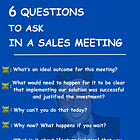Guiding Realizations: The Psychology of Questions that Sell
Helping the buyer see what's true for themselves
Asking questions in a sales meeting shouldn’t be complicated nor should it be a cause of stress.
There are 2 (not so) separate categories of questioning:
Questions that determine fit
Questions that guide realizations
Chad note: There is obvious overlap between the 2 categories. You can argue that the point of every question is to determine fit. And determining fit is a sort of realization in and of itself.
But for the sake of clarity, I separate the two.
Questions that Determine fit
These are your key criteria. The questions you need answers to in order to determine if the prospect is suitable to be your next customer, irrespective of the problem they want solved.
In other words, no matter how much pain the prospect is in, how much they appear to need your solution, and how able and willing they are to buy it from you, failure to satisfy this criteria immediately disqualifies them.
Every industry has this criteria. For some it’s “they must be using XYZ technology” and for others it’s “must have a minimum team size or headcount” etc
What are your dealbreakers?
Chad note: People feel safe when they know your dealbreakers and boundaries. It provides a container for the other and shows you have standards.
Questions that determine fit often revolve around:
Budget
Decision making process
Technical fit / ecosystem
Timing / urgency
Legal or compliance blockers
Understanding these things is obviously important, but still surface level compared to what I’m about to share in the next section.
It is also worth noting that these “BANT-style” questions are problem dependent. The scope and severity of the buyer/company’s problem will naturally influence their budget, urgency, and decision dynamics.
The downside of these questions is they are inherently seller focused. They serve your process more than the buyer’s experience and add little value. When overdone, which it often is, it drains energy from the conversation and creates buyer resistance.
That’s why extracting this information must be done delicately. Be sensitive and attuned to the energetic balance between giving and getting. Most sellers screw this up.
Related readings:
-
If you’re looking for more examples of Questions that Determine fit, these 6 questions have become a staple of mine and many of my clients:
**Chad note: Obviously not all need to be asked because some will be answered indirectly depending on the conversation.
Guiding Realizations
These are the questions where the selling really happens.
If the first category (fit questions) is about understanding the surface level logistics, these are the questions that move people. They also serve as effective follow up questions to the “fit questions” too.
It is a lot of fun when executed well!
When I teach clients how to guide others to a realization, we start with this fundamental principle:
Selling is a deliberate and intentional way of communicating that gets the other side to discover or realize the truth themselves.
People buy emotionally, and justify it intellectually. This is how every decision is made.
So the next step is to design questions that guide the buyer through that decision making process. By leading both the heart and the mind to new realizations.
You’re satisfying both “internal advisors” inside the human being in front of you.
Selling to the Heart
Non Verbal & Vibes
The simplest (but not easiest) way to create emotional connection is to embody the emotion you want to elicit.
You model what’s disowned or unexpressed in the other person which acts as an implicit invitation for them to feel it too.
In my humble cartoon opinion, you can’t be as effective as you could be until you actually feel the emotion you’re trying to evoke. You don’t have to feel it in the moment, but you must at least be able to share in the experience of the other.
On some level, we’re all judged by our ability to relate. And if you want to be convincing, then your ability to relate is critical.
Don’t just say “Oh that’s frustrating” .. actually mean it:
“Oh wow.. ugh.. *slight pause*.. that is frustrating..” said with a felt sense of frustration
or
“That seems really annoying” delivered with genuine annoyance. Not a flat “Sorry to hear that”
Saying it vs meaning it is the difference between connection and disconnection. It’s almost entirely non verbal (tone, intention and vibe)
Technique: Emotional Priming
Before your meetings, recall two real experiences from your own life:
a time you felt deep frustration, pain, or annoyance about something unresolved
a time you felt genuine hope or excitement about a possible solution
Sit with each memory and notice what it felt like.
Those are the poles your buyers live between: Pain and Possibility.
Now when you’re in a meeting, whether the buyer is leading with Pain or Possibility, recall those feelings. Let them subtly affect and color your tone and body language.
Simple reflective statements such as “That’s frustrating” or “That’s exciting” will land with more resonance.
Word Choice and Framing
Getting the non verbal right will do much of the heavy lifting for you. But language is still important.
You can add emotional charge and “texture” to your questions by playing with the word choice and Framing:
🤡: Do you have adequate coverage every month and reporting period?
🐲: Are you happy with the amount and quality of coverage you have for every reporting period?
or
🐲: When you think about coverage for the last reporting period, or the ones before that.. I mean, are you happy with the quality?
—
🤡: How would things change for you and the team if you weren’t “getting down to the wire” every month?
^ feels too leading. delivery would need to be immaculate.
🐲: When you say your team is “getting down to the wire” .. what’s that like?
-
Inject more emotion and imagery into your phrasing:
“You’re scrambling to get the reports done each month?”
“It seems like you kind of have your hands tied trying to manage all this”
“That sounds like a nightmare”
The realization you’re guiding them to has NOTHING TO DO WITH THE RATIONAL MIND. This is purely emotional with the intent of increasing their awareness about how they feel about their situation.
Selling to the Mind
The mind is the domain of thinking.. of reasoning, evaluating, and drawing conclusions.
It always looks for evidence to justify the beliefs that were usually made unconsciously and emotionally. And it’s in the mind that we create the stories that define who we are and how we operate.
If you’ve done the emotional work right, the mind becomes receptive. It is ready to make sense of what the heart feels.
That said, the mind still needs data, i.e: numbers, ROI, facts, proof. Especially in B2B.
The mind also:
Clings to stories, even if they are wrong, in order to maintain certainty.
Argues if it feels threatened
Creates problems that don’t exist. And downplays the ones that do.
Create the Frame they’d want to enter
Demonstrate you understand why the problems that the person is already emotionally invested in solving for, exists, as well as or ideally, better than they do.
Do it through your questions and the insights embedded in both your questions and answers.
This creates the opening and receptivity to then show how people or companies like them are getting what they want by using your solution (typically done via a live demonstration, case studies, etc)
Demonstrating you understand why their problems exist
This only matters if they are emotionally invested in solving their problem. Otherwise, it’s a waste of time engaging in mental gymnastics.
Ask yourself:
Why does this problem exist?
What creates or sustains it?
What are the real root causes?
Knowing this implies you also know how to solve it. This is how you create the perception of Status. How you Prize yourself.
I tell every client to research the problem they solve for and best practices / new ways to solve it like they are running a 7 figure consultancy.
You’d know your shit like the back of your hand wouldn’t you?
Study regularly.
From there ask questions that make the buyer realize two things:
You get it
You might be the one who can fix it
Technique 1: “Are you able to..?”
One of my favorite questions. It does two things simultaneously:
Reveals a potential problem
Creates intrigue.
When someone hears “Are you able to do X?” the mind reacts by asking:
“Should we able to?” or “Why can’t we?”
That moment of reflection is gold, anon.
Framework:
“Are you able to.. → [insert the better process/technology your company has]?”
Example:
🐲: Are you able to feed personalized buyer info directly to your marketing campaigns to improve the odds of conversion?
>>No, we can’t.
Which leads to..
Technique 2: If/Then Chains
“If/Then” questions guide the prospect to reason through the consequences of their current situation:
🐲: If you’re treating every lead the same, then how do you expect conversion rates to improve?
»Yeah.. I guess we can’t..
🐲: And if that keeps happening, then how do you plan to scale the business, or sell it in 5 years?
*realization sets in*
Try this and see how it works for you. If you want help applying this in your world then let’s chat and see if the Accelerator and/or 1:1’s are the right choice for you.
Programs & Trainings
The Accelerator
A high intensity 12 week group coaching program. Limited to 10 participants. Through live teachings and active roleplaying, you’ll learn how to deeply understand your buyers, ask powerful questions, and be in control of your deals.
More details here:
—
If you’re ready to enroll, you can here:
The Chad Salesman Course
My flagship course. A no-BS self study course that transforms average sellers into top performers.






